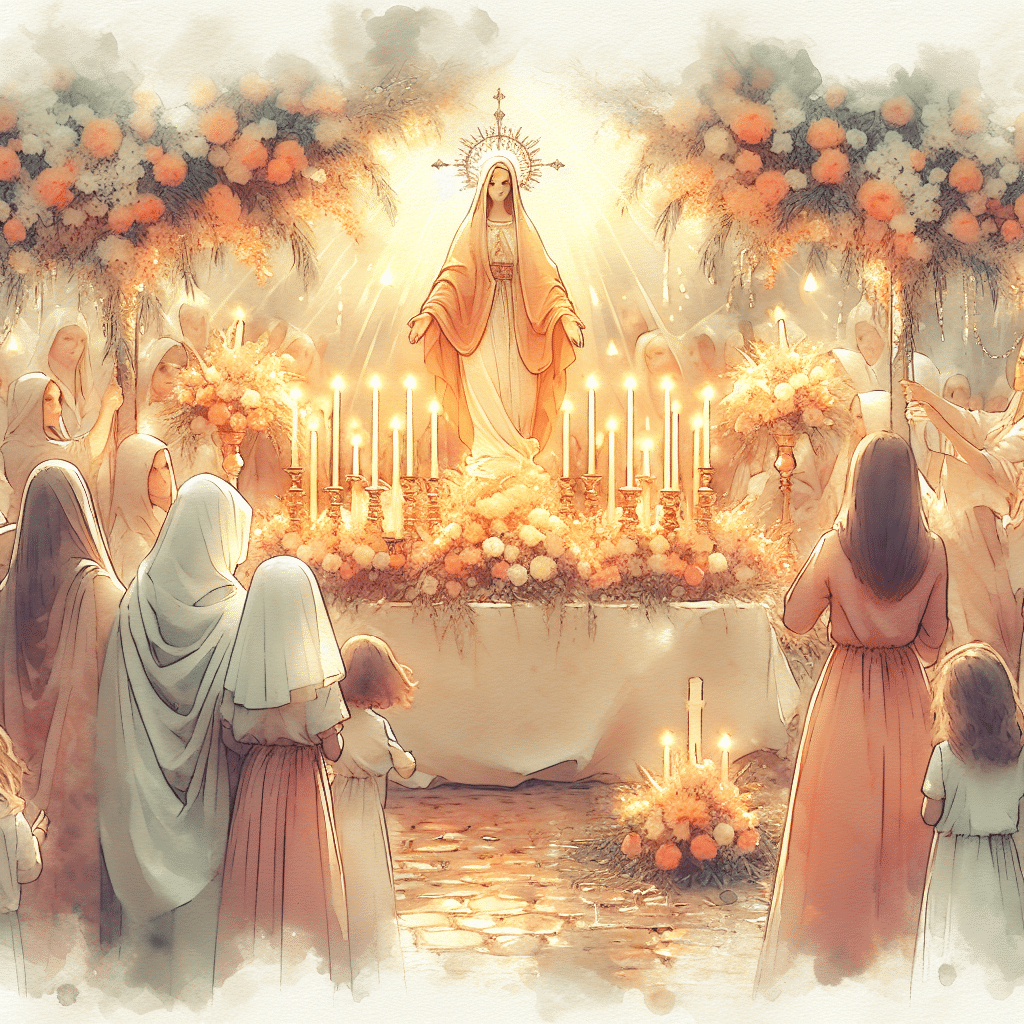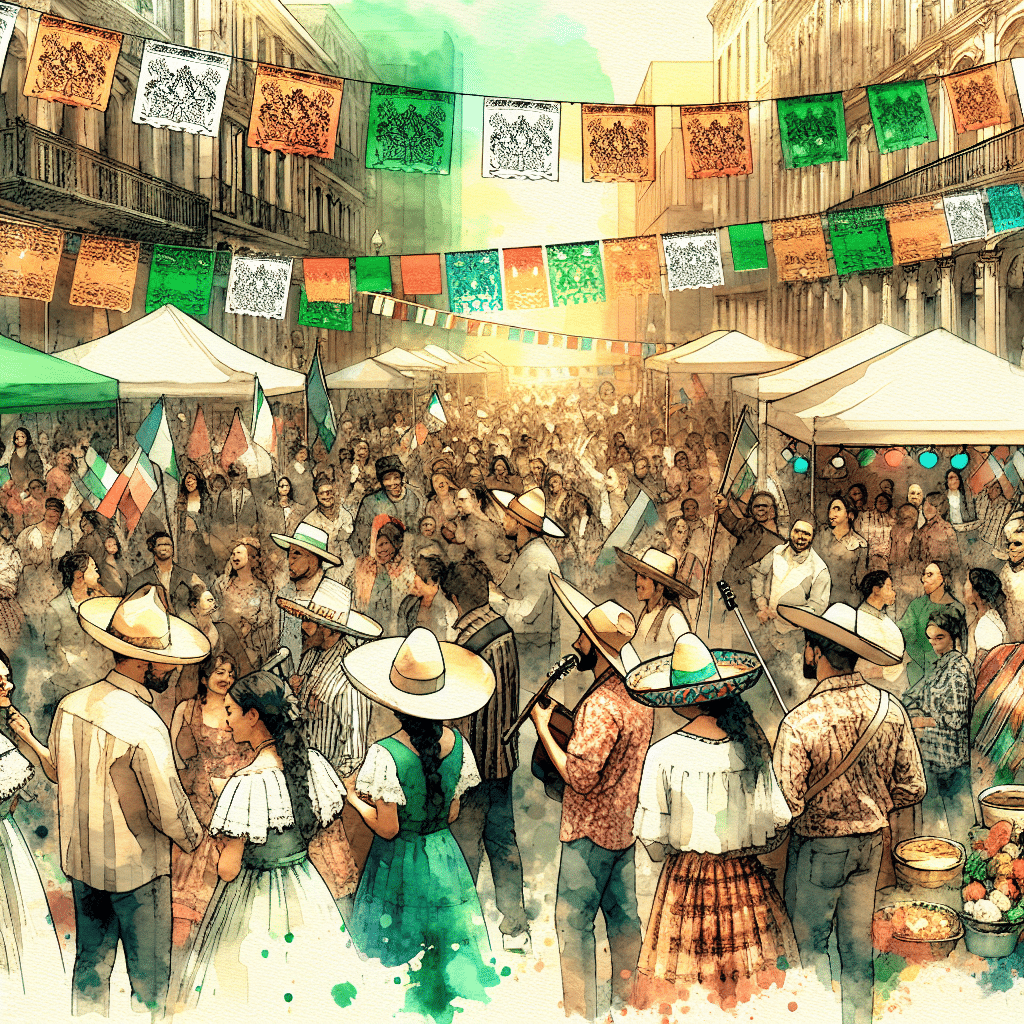
The Feast of the Assumption: Celebrating Mary’s Heavenly Ascension
The Feast of the Assumption
Origins and History
The Feast of the Assumption, celebrated on August 15th, is a major event in the Catholic Church. This isn’t just any feast—it’s steeped in centuries of tradition and lore. The belief that Mary, the mother of Jesus, was taken up into heaven body and soul at the end of her earthly life has been around since the early days of the Church (Catholic News Agency).
The origins of this celebration can be traced back to as early as the 5th century. In the East, Emperor Maurice established the Feast of the Dormition around AD 600. By the 7th century, this feast made its way to the West, where it became known as the Feast of the Assumption. St. Juvenal, Bishop of Jerusalem, shared at the Council of Chalcedon in 451 that Mary died in the presence of all the Apostles, but her tomb was found empty, leading to the belief that her body was taken up to heaven.
From there, things only got more official. Pope Leo IV and Pope Nicholas I elevated the feast’s status. By the time Pope Benedict XIV got around to it, denying Mary’s assumption was considered impious and blasphemous (Wikipedia).
Dogma Defined
Fast forward to 1950, and Pope Pius XII decided to make things crystal clear for everyone. He declared the Assumption of Mary an official dogma of the Roman Catholic Church in his apostolic constitution Munificentissimus Deus (Wikipedia). According to this dogma, Mary “having completed the course of her earthly life, was assumed body and soul into heavenly glory” (Boston Public Library).
This wasn’t just some random declaration. The belief in Mary’s assumption was already a widely-held tradition and a frequent meditation in the writings of saints throughout the centuries (Catholic News Agency). Pope Pius XII’s pronouncement simply made it official, giving Catholics worldwide a reason to celebrate with even more gusto.
Want to dive deeper into the nitty-gritty details of the Feast of the Assumption? Check out our comprehensive guide on the Feast of the Assumption and other Catholic feast days. Whether you’re curious about the religious observances or just want to know how to join the festivities in Latin America, we’ve got you covered.
Why the Assumption Matters
Mary’s Heavenly Journey
The Assumption of Mary is a big deal in Catholic tradition. It’s the belief that when Mary’s time on Earth was up, she was taken up to heaven, body and soul (Catholic News Agency). This was officially declared a dogma in 1950 by Pope Pius XII, making it an unchangeable part of Catholic faith.
Historical records, like those from the Council of Chalcedon in 451, back this up. St. Juvenal, Bishop of Jerusalem, said that after Mary died, her tomb was empty, suggesting she was taken up to heaven (Wikipedia). This event highlights Mary’s special place in Catholicism and her close connection with God.
August 15th: A Day to Celebrate
Assumption Day, celebrated on August 15th, is a major feast in the Catholic Church. It marks the end of Mary’s earthly life and her assumption into heaven. This day is filled with religious and cultural festivities worldwide.
In countries like Spain, Italy, and France, Assumption Day is a public holiday. People celebrate with colorful parades, performances, and fireworks. These celebrations mix religious practices with local traditions, showing the many ways communities honor this important event.
| Country | Public Holiday |
|---|---|
| Andorra | Yes |
| Austria | Yes |
| Belgium | Yes |
| France | Yes |
| Greece | Yes |
| Italy | Yes |
| Lebanon | Yes |
| Poland | Yes |
| Portugal | Yes |
| Spain | Yes |
Assumption Day holds special meaning for those balancing their Latino heritage and American lifestyle, offering a rich blend of traditions that reflect their dual cultural identity. For more on festivals in Latin America and Virgin Mary celebrations, check out our related articles.
Cultural Celebrations Worldwide
Assumption Day, celebrated on August 15th, is a big deal in many countries. It’s all about honoring the belief that Mary, the mother of Jesus, was taken up into heaven. Let’s check out some of the cool traditions and festivities that make this day so special.
Assumption Day Traditions
Assumption Day is a public holiday in several countries like Austria, Belgium, France, Greece, Italy, and Spain. Celebrations in these places often include lively processions, stunning performances, and jaw-dropping fireworks. Each region adds its own twist, making Assumption Day a truly global party.
| Country | Assumption Day as Public Holiday |
|---|---|
| Austria | Yes |
| Belgium | Yes |
| France | Yes |
| Greece | Yes |
| Italy | Yes |
| Spain | Yes |
| Portugal | Yes |
| Poland | Yes |
In Europe and South America, Assumption Day is a time for community gatherings and religious observances. Colorful processions often feature statues and icons of the Virgin Mary, symbolizing her journey to heaven. These processions are accompanied by music, dances, and sometimes even dramatic reenactments of Mary’s assumption.
For more on how different regions celebrate this day, check out our article on festivals in Latin America.
Festivities in Italy
In Italy, Assumption Day is known as Ferragosto and is celebrated with great enthusiasm. This national holiday sees schools, businesses, and various organizations closing for the day, while towns and cities come alive with celebrations.
One of the most iconic events is the Palio di Siena, a thrilling horse race held in the Tuscan city of Siena. This event, which takes place in the Piazza del Campo, draws crowds from all over the world. The race is not only a test of speed but also a display of pageantry and tradition.
Assumption Day in Italy also features grand processions where statues of the Virgin Mary are carried through the streets. These processions are often accompanied by prayers, hymns, and lots of enthusiastic participants. Firework displays light up the evening sky, adding a touch of magic to the celebrations.
| Italian City | Notable Event |
|---|---|
| Siena | Palio di Siena |
| Rome | Processions |
| Naples | Fireworks |
| Venice | Water Procession |
Symbols of the Virgin Mary, such as statues and icons, are prominently displayed and revered during these celebrations. For more on the significance of these symbols, see our article on Virgin Mary celebrations.
Assumption Day in Italy is a blend of religious observance and cultural festivities, making it a day that brings people together in celebration of both faith and heritage. For more on how this day fits into broader Latino cultural events, explore our section on Hispanic cultural events.
Assumption Day in Catholicism
The Assumption of Mary is a big deal in the Catholic calendar, celebrated with loads of enthusiasm and devotion. Let’s dive into the religious practices and the special place Mary holds in Catholic beliefs.
Religious Observances
On August 15th, Catholics around the globe celebrate Assumption Day, marking the end of the Virgin Mary’s earthly life and her being taken up into heaven. This day is more than just a holy day of obligation; it’s a full-blown celebration, often involving processions, feasts, and special masses.
Here’s a peek into how Catholics celebrate the Assumption of Mary:
| Activity | Description |
|---|---|
| Mass Attendance | Devotees head to churches to attend mass, where the sermon usually focuses on the life and virtues of the Virgin Mary. |
| Processions | Many communities organize processions, parading statues of Mary through the streets to honor her assumption into heaven. |
| Feasting | No religious celebration is complete without food, and Assumption Day is no exception. Feast tables overflow with traditional dishes. |
| Public Holidays | In many countries, August 15th is a public holiday, giving everyone a chance to join in the festivities. |
For more on how this day is celebrated in different cultures, check out our article on festivals in Latin America.
Mary’s Role in Catholic Beliefs
Mary, the Immaculate Mother of God, holds a special place in Catholicism. According to the dogma defined by Pope Pius XII in 1950, Mary was assumed body and soul into heavenly glory after completing her earthly life. This event underscores several key beliefs in Catholicism:
- Intercessor: Catholics believe that Mary intercedes on their behalf, playing a crucial role in their spiritual lives.
- Model of Virtue: Mary is seen as the epitome of purity, obedience, and faith, serving as a model for all believers.
- Queen of Heaven: The assumption doctrine reinforces the idea of Mary being crowned as the Queen of Heaven, emphasizing her exalted status.
The word “assumption” itself comes from the Latin “assūmptiō,” meaning “taking up,” which highlights the belief in the resurrection of both body and soul. This belief aims to strengthen the faith of Catholics in the resurrection of all believers.
For more insights on the Virgin Mary’s role in various celebrations, visit our article on Virgin Mary celebrations.
By understanding these religious observances and the pivotal role Mary plays in Catholic beliefs, one can appreciate the depth and significance of the Assumption Day celebration within the Catholic faith.
Artistic Depictions and Symbols
Iconography of the Virgin Mary
When Assumption Day rolls around, the Virgin Mary often takes center stage. From her iconic blue cloak to her serene expression, Mary has inspired artists for centuries. Big names like Rubens, Duccio, Leonardo da Vinci, Michelangelo, Raphael, Giovanni Bellini, and Caravaggio have all tried to capture her divine essence. One standout example is Rubens’ “Assumption of Mary” from around 1626.
Mary is often shown with symbols like the crescent moon, stars, and angels lifting her to heaven. These aren’t just pretty details; they pack a punch in meaning. The crescent moon stands for her purity, the stars mark her as the Queen of Heaven, and the angels? They’re her heavenly Lyft.
Artworks Celebrating the Assumption
The Assumption of Mary might sound heavy, but artists have made it visually stunning. The Feast of the Assumption celebrates when the Virgin Mary was taken—body and soul—into heaven. This event has sparked countless masterpieces.
| Artist | Artwork | Year |
|---|---|---|
| Rubens | Assumption of Mary | 1626 |
| Duccio | Maestà | 1308-1311 |
| Leonardo da Vinci | The Annunciation | 1472-1475 |
| Michelangelo | Sistine Chapel Ceiling | 1508-1512 |
| Raphael | Sistine Madonna | 1512 |
| Giovanni Bellini | The Assumption of the Virgin | 1510 |
| Caravaggio | The Death of the Virgin | 1601-1606 |
These pieces aren’t just religious icons; they’re cultural treasures. They show the lasting impact of the Virgin Mary in both art and religion. For more on the history and cultural significance of these artworks, check out our sections on Feast of the Assumption and Virgin Mary Celebrations.
By exploring these artistic depictions, you can appreciate the rich tapestry of symbols and stories that surround the Assumption Day celebration. Whether you’re a devout believer or an art lover, there’s something deeply captivating about these portrayals of Mary. For those interested in Latino cultural events and their artistic expressions, don’t miss our articles on Hispanic Cultural Events and Traditional Latino Celebrations.
Feast Day Traditions in Greece
When it comes to celebrating the Dormition of the Virgin Mary, Greece goes all out. This isn’t just any feast day—it’s a full-blown, multi-day bash steeped in history, culture, and a sprinkle of the miraculous. Let’s jump into the unique festivities and traditions that make this celebration unforgettable.
Dormition Celebrations
The Dormition of the Virgin Mary kicks off on August 15th, drawing believers from every corner of Greece. One of the most famous spots is the Church of the Blessed Virgin in Tinos, where worshippers flock to venerate the miraculous image of Mary. The party doesn’t stop there; it continues until August 23rd, marking the anniversary of the sinking of the battleship Elli by the Italians.
On the Ionian island of Kefalonia, the Holy Monastery of Panagia Fidousa becomes the center of attention. Here, tiny snakes, considered to be a good omen, mysteriously appear in the belfry. Legend has it that these snakes saved nuns from pirates back in the year 1200. Their miraculous appearance is eagerly awaited, and their absence is seen as a bad sign.
Unique Festivities
Greece doesn’t just celebrate with prayers and solemn rituals; they know how to throw a party. Take the island of Koufonissia, for instance. Worshippers gather around the church to enjoy a feast in honor of the Virgin Mary and even hold a sailboat race in the harbor to celebrate her grace.
In Mikrokasto, Kozani, the eve of the feast sees pilgrim riders making their way to the Virgin Mary Monastery. This tradition, dating back to the Ottoman Empire, symbolizes the bravery of slaves who displayed their horse-riding skills. After this ride, they return to Siatista for more celebrations.
On the island of Alonissos, the festivities include a reenactment of a traditional wedding. Locals dress up and participate in the celebration with live traditional music and dances, making it a day to remember.
| Celebration Site | Unique Tradition |
|---|---|
| Tinos | Venerating the miraculous image of Mary |
| Kefalonia | Appearance of tiny snakes in the belfry |
| Koufonissia | Feast and sailboat race |
| Mikrokasto, Kozani | Pilgrim riders to the monastery |
| Alonissos | Reenactment of a traditional wedding |
These vibrant and unique festivities make the Dormition of the Virgin Mary a celebration that resonates deeply with the Greek Orthodox faithful. For more on Virgin Mary celebrations and other Catholic feast days, explore our related articles.
Local Customs and Legends
Assumption Day, celebrated on August 15th, is more than just a religious holiday. It’s a day packed with unique customs and legends that bring communities together in special ways.
Miraculous Occurrences
In many places, Assumption Day is known for miraculous events that add a touch of magic to the celebrations. Take the Ionian island of Kefalonia, for example. Every year, believers head to the Holy Monastery of Panagia Fidousa to see small snakes that mysteriously appear in the belfry. These snakes are seen as a sign of good luck, and if they don’t show up, it’s considered a bad omen. This legend goes back to the year 1200 when the snakes supposedly saved nuns from pirates.
In Tinos, Greece, the celebration centers around the miraculous image of Mary at the Church of the Blessed Virgin. The festivities stretch until August 23rd, marking the anniversary of the sinking of the battleship Elli by the Italians. This extended celebration mixes faith with national history, making it a unique blend of reverence and remembrance.
Traditional Practices
Assumption Day is also rich with traditional practices that showcase the cultural heritage of different communities. On the island of Koufonissia, people gather around the church for a feast in honor of the Virgin Mary. The festivities include a sailboat race in the harbor, adding a nautical twist to the celebration.
In Mikrokasto, Kozani, pilgrim riders on the eve of the feast ride to the Virgin Mary Monastery at Mikrokasto before heading back to Siatista for more celebrations. This horse-riding tradition dates back to the Ottoman Empire and symbolizes the bravery of slaves showing off their skills.
On Alonissos Island, the celebration features a reenactment of a traditional wedding. Locals dress up and join in live traditional music and dances. This practice not only honors the Virgin Mary but also keeps cultural traditions alive, making the feast a lively and colorful event.
To learn more about the significance of the Assumption and its global celebrations, check out our articles on the feast of the assumption and festivals in Latin America. These customs and legends make Assumption Day a vibrant celebration that beautifully blends faith, history, and culture.
Modern Celebrations and Events
Contemporary Observances
Assumption Day, celebrated on August 15, is a big deal in many countries, especially in Europe and South America. This day honors the belief that Mary, the mother of Jesus, was taken up to heaven, body and soul. Across the globe, modern festivities mix old traditions with new twists, making it a lively holiday you won’t want to miss.
In countries like Austria, Belgium, France, and Italy, Assumption Day is a public holiday. Even in places where it isn’t an official holiday, like the US and the UK, people still celebrate with lots of enthusiasm. Colorful parades, lively performances, and dazzling fireworks light up the day and night.
| Country | Public Holiday | Celebratory Activities |
|---|---|---|
| Italy | Yes | Parades, Palio di Siena, Fireworks |
| Greece | Yes | Church services, Feasts, Unique local customs |
| United States | No | Church services, Community events |
Festivities Around the World
Italy
In Italy, Assumption Day is called Ferragosto and is celebrated with a lot of excitement. The streets come alive with parades featuring statues of Mary, and the Palio di Siena, a historic horse race in Tuscany, takes place around the Piazza (Time and Date). The evening skies light up with spectacular fireworks displays, making it a day of both solemnity and fun.
Greece
Greece has its own unique ways of celebrating the Dormition of the Virgin Mary. On Tinos island, thousands of believers flock to the Church of the Blessed Virgin to venerate the miraculous image of Mary. Festivities last until August 23, marking the anniversary of the sinking of the battleship Elli (Office Holidays Blog). On Kefalonia island, small snakes appear in the belfry of the Holy Monastery of Panagia Fidousa—a phenomenon considered lucky and tied to a legend dating back to 1200 (Office Holidays Blog).
Latin America
In Latin America, Assumption Day is a day of deep cultural and religious significance. In Guatemala, for instance, the celebrations include colorful processions, traditional dances, and community feasts. The day is marked by a vibrant display of faith and culture, blending Catholic traditions with local customs. For more on Latino celebrations, check out our festivals in Latin America page.
By exploring the diverse and colorful ways in which Assumption Day is celebrated around the world, one gets a glimpse into the rich tapestry of cultural and religious traditions that make this day truly special. Whether you’re attending a parade, enjoying a feast, or watching fireworks, the spirit of the Assumption Day celebration is sure to leave a lasting impression. For more details on these festivities, visit our pages on traditional Latino celebrations and latino religious festivals.




